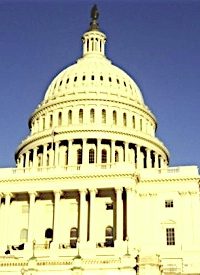
According to a Gallup generic ballot for Congress among registered voters, Republicans maintain a 3-point lead over Democrats, 46 to 43 percent. To boot, polling of likely voters from September 23 to October 3 show Republicans with a double-digit lead under two separate turnout scenarios: Likely voters, higher turnout: 53 percent Republicans to 40 percent Democrats; likely voters, lower turnout: 56 percent Republicans to 38 percent Democrats.
Gallup explains:
These initial estimates are based on interviews with more than 3,000 national adults, including more than 2,700 registered voters, and more than 1,800 adults who demonstrate a high probability of voting this fall, based on their answers to Gallup’s standard likely voter questions that probe current voting intentions and past voting behavior.
Among registered voters interviewed over this period, the parties continue to have rough party on Gallup’s generic ballot for Congress, as they have since early September. If all voters turnout out at this point, the national vote would be close, with Republicans having the slight edge.
Within both likely voter polls, Republicans are highly likely to vote for the Republican candidate, and Democrats for the Democratic candidate. Independents in both likely voter models skew strongly toward the Republican candidate. Gallup has found independent registered voters consistently preferring Republican candidates throughout the campaign.
Gallup’s method for identifying likely voters has dated back to 1950, and has proven to be highly accurate.
The Wall Street Journal reports that one of the most disconcerting figures for the Democrats is the “low turnout model,” which is a typical phenomenon of midterm elections. WSJ writes, “If the Gallup numbers hold up (and the firm cautions that ‘the race often tightens in the final month of the campaign), some word more cataclysmic than ‘tsunami’ would be needed for the Democratic losses.”
The Wall Street Journal adds that the Democrats have “downplayed the Gallup numbers, pointing out that Gallup’s surveys have been somewhat volatile this year and other polls (such as those by Scott Rasmussen) show a much smaller GOP edge among likely voters, on the order of three percentage points. That would translate into a GOP House gain of 35 to 40 seats, hovering just around what Republican would need to take control of the Speaker’s gavel.”
It contends, “But regardless of where likely voters are right now, it’s a strange political year when Democrats start consoling themselves with Scott Rasmussen, whose polls they have long disparaged as being biased towards Republicans.”
Political analyst Dick Morris contributed to the debate over the Republican victory in the fall. He noted that October 6 was a big day for the Republicans as it was “the first day this year that the Republican candidate leads in the most recent poll in ten Senate races for Democratic seats. If the Republicans hang onto these leads, they are assured of a majority! Even more important, the Republican is moving up in all ten races even where the margin is still narrow!”
Realclearpolitics.com shows the following figures:
North Dakota: Republican + 43 percent
Arkansas: Republican +18 percent
Indiana: Republican +18 percent
Wisconsin: Republican + 12 percent
Pennsylvania: Republican +7 percent
Colorado: Republican +5 percent
West Virginia: Republican +5 percent
Illinois: Republican +4 percent
Nevada: Republican +3 percent
Washington: Republican +1 percent
Of those figures, the most notable perhaps is that of Nevada, where Sharron Angle has either been tied with Senate Majority Leader Harry Reid, or trailed by two to three points, until only recently, when she edged ahead by three points.
Morris notes, “In Connecticut, Linda McMahon is hot on the heels of Richard Blumenthal. In New York State, the last published poll had Republican Joe DioGuardi one point behind appointed Senator Kristen Gillibrand, but that poll is now two weeks old. In Delaware, the last poll is two weeks old and showed Democrat Coons way ahead, but it may well have closed since. The only piece of bad news is that Fiorini is 3 points behind Boxer, but Barabara is still under 50 percent of the vote.”
Dick Morris appeared on yesterday’s episode of The O’Reilly Factor. Aware that the President’s popularity rating will have a direct effect on the results of the midterm elections, O’Reilly noted, “Obama is on the ballot this coming November.”
If that is indeed true, President Obama’s standing among white working voters will not bode well for the Democratic candidates in November. In 2008, those voters preferred Republican candidates 53 to 42 percent, but in 2010, those same voters prefer Republican candidates over Democratic candidates, 58 to 36 percent.
Both Morris and O’Reilly attribute the numbers to both the economy and the culture, though Morris believes that the economy is the far greater catalyst, particular the debt and the unemployment figures.
O’Reilly contends that Obama’s positions on key issues are “not in sync” with many American voters, including immigration and the Ground Zero mosque.
While the President is believed to rely heavily on the minority vote, a new study by the Pew Hispanic Center shows that about half of Hispanic-American voters may not vote in November.
Morris asserted, “The Democrats have made a fundamental mistake thinking they could get [Hispanics] back over immigration,” since only 31 percent of Hispanics cited immigration as an important issue in the Pew Hispanic Center survey. In contrast, 54 percent cited jobs as a key issue.
Co-author of the Almanac of American Politics, Michael Barone, claims that the Gallup turnout models would produce “a Republican House majority the likes of which we have not seen since the election cycles of 1946 or even 1928.” He adds that the parallel might not be able to be made to the 1994 results, where the GOP gained 54 House seats, but instead to the 1894 election, when Republicans gained 100 House seats.




